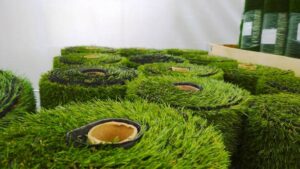Updated on August 1, 2023
Artificial Grass – An Eco-Friendly Alternative to Natural Lawns
Artificial grass offers homeowners an appealing lawn alternative, saving time and reducing airborne chemicals.
Artificial turf is often constructed using yarns made of polyethylene, polypropylene and nylon that mimic real grass in terms of materiality and weave patterns. A thatch layer may also be included to mimic its inconsistencies.
Easy to Maintain
Artificial grass SA does not need watering, fertilization or mowing in order to stay lush and green all year-round; however, some regular care must still be given in order to preserve its appearance.
Regular maintenance of your synthetic lawn is crucial to reducing bacteria, dirt and debris build-up. To do this, simply sweep or brush in the direction your turf grows with a plastic-handled turf rake (a metal one could damage fibers), so the blades remain upright without stuck-on debris.
For pet waste related messes, antimicrobial spray such as PoopClenz may help to reduce odors and kill bacteria spores while encouraging urine drainage from synthetic lawn surfaces. In order to keep up with this task, regularly flushing your synthetic lawn surface may also help.
If your region experiences snowfall, be sure to remove it promptly in order to avoid leaving behind scuff marks and allow the snowpack to melt away more efficiently. This will also allow any possible accumulations to dissipate more easily.
Use of a leaf blower on synthetic lawns should be avoided as this can damage its grass fibers, as this could do irreparable harm to its surface. A push broom should be used instead when there are many leaves or sticks present, and light rinsing with a hose on a regular basis will also help to keep your turf looking its best.
Durable
Artificial grass SA offers several advantages over its natural counterpart, including reduced bacteria growth, more resistant fading from sunlight, no need for replacement often and pet-friendliness; pet owners can rest easy knowing their kids will play safely on it while eliminating chemicals which may harm both animals and children alike. Unfortunately, some medical experts claim certain types of artificial grass contain lead which could contribute to decreased development or mental retardation among young children.
When purchasing artificial grass, pay special attention to its face weight and thatch layer. Face weight measures how many ounces of material per square yard there is in the turf; higher numbers indicate better quality. Thatch layers add an authentic appearance by covering each blade of artificial grass with different color, weight, and texture to give a realistic appearance – look for one with variations that mimic real grass’ inconsistencies!
Considerations should also be given to the pile height, infill density and density of synthetic grass. A lower pile height is best for high traffic areas while longer pile height creates more luxurious lawns that mimic real turf lawns. Hose down your turf regularly in order to remove dust and debris; additionally if you have pets be sure to promptly pick up solid waste as soon as it accumulates to avoid unpleasant odors and stains from accumulating on it.
Eco-Friendly
 Artificial grass is an eco-friendly alternative to natural lawns. It saves water, reduces your carbon footprint, and doesn’t require chemicals such as herbicides and pesticides – especially helpful if your area suffers from water shortages.
Artificial grass is an eco-friendly alternative to natural lawns. It saves water, reduces your carbon footprint, and doesn’t require chemicals such as herbicides and pesticides – especially helpful if your area suffers from water shortages.
Natural lawns also require regular mowing and watering, which can be costly as these tasks often necessitate electric or fossil fuel mowers and water pumps as well as chemical fertilizers that could harm ecosystems by leaching into nearby water sources, polluting drinking water sources or even killing aquatic life.
Synthetic turf saves water while eliminating the need for toxic weed killers and pesticides that are toxic when swallowed by pets or children and potentially hazardous for wildlife and humans alike. Furthermore, they often leave behind residue on the ground which is difficult to eliminate.
Make your fake turf even more eco-friendly by selecting an organic infill such as Safeshell. Made up of green silica sand and black crumb rubber, Safeshell was the first turf infill certified USDA BioPreferred for safe use by humans and animals (and plants!). Furthermore, its cooling qualities won’t increase surface temperatures; plus being made from recycled materials makes this an eco-friendly choice.
Affordable
Artificial grass products on the market cater to nearly every climate, use, and location. Nylon turf features a stiff pile that performs well under hot temperatures while looking more realistic than natural grass; additionally it comes equipped with brown thatch for even greater realism. Although this synthetic lawn may be costly initially, its lifespan can last 25+ years!
Artificial grass SA requires a base material consisting of crushed rock or decomposed granite with landscaping fabric to prevent weed growth, at a cost that depends on its size. A 1,000-square-foot backyard will need more gravel than smaller spaces for instance. In addition, prior to installing any turf it must first be prepared and leveled by clearing away trees, rocks or debris as well as adding a weed barrier barrier.
Synthetic turf differs from traditional lawns in that it does not require watering on a daily basis; however, it still must be regularly raked and blown off for cleanliness purposes and treated with an odor control product if you own pets. While these costs can quickly accumulate, they’re far cheaper than keeping an old-fashioned lawn looking its best!
Synthetic turf offers another key advantage: no regular mowing required! Not only can this save money and time on gas consumption costs, but it reduces air pollution caused by lawn mowers; according to research, just one lawnmower produces as many emissions as 11 cars running for an hour!
